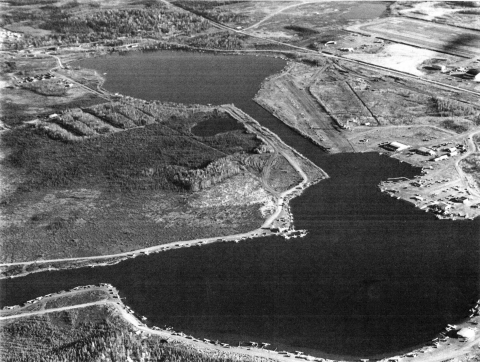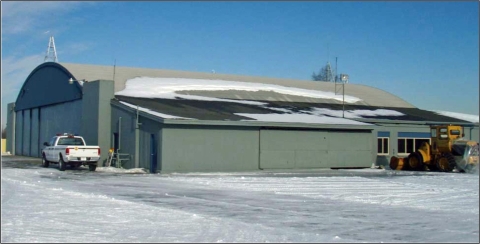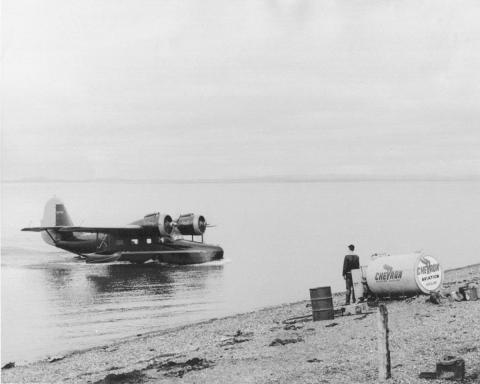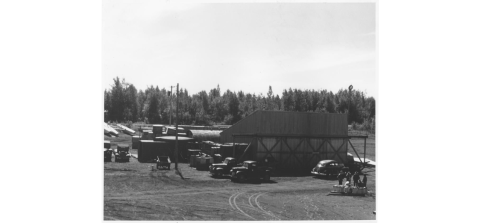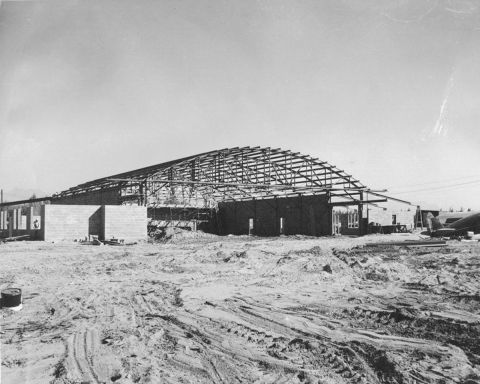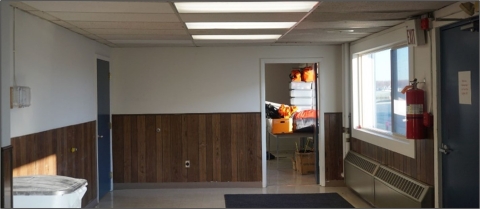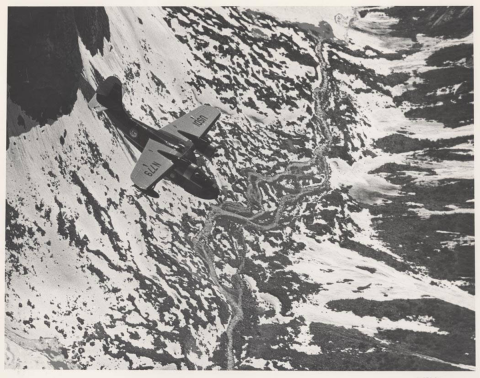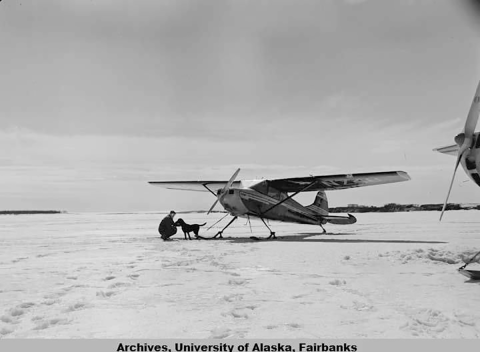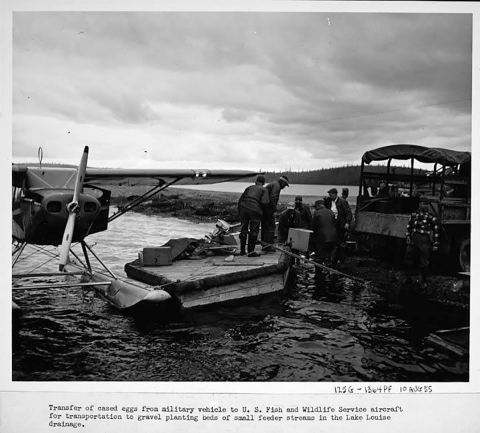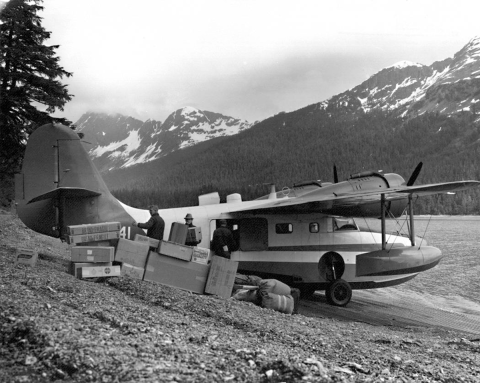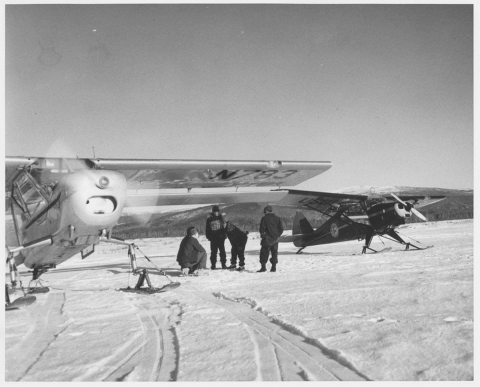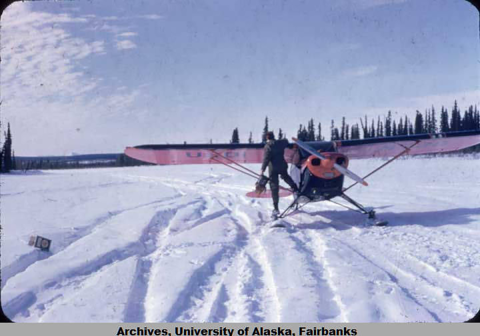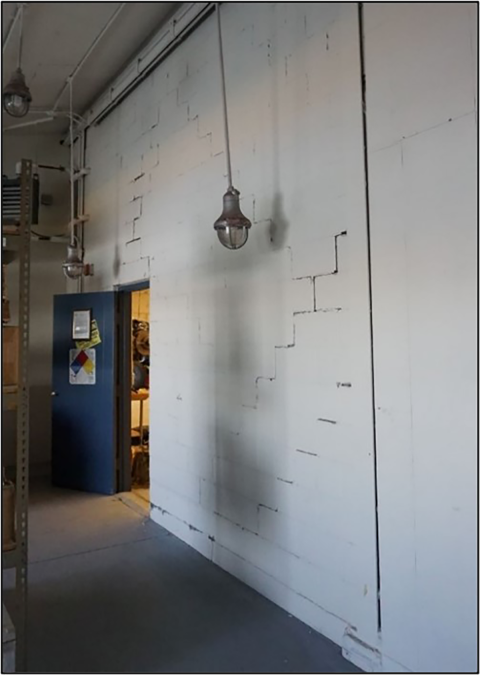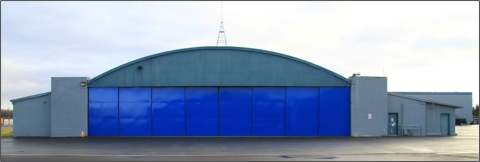Anchorage was established in 1915 as a tent city for the construction of the Alaska Railroad. At that time, there were no highways, railroads, or major airports in the state, and travel to most places was impossible outside of taking a floatplane, boat, or dogsled. Floatplanes were critical to travel for much of the early history of Anchorage as people traveled to cabins, hunting camps, and remote communities.
Before the development of Lake Hood, Lake Spenard had been Anchorage’s seaplane base since the 1920s (Faith 2009). However, Lake Spenard was too small for fully loaded floatplanes, and aircraft operations bothered people using the lake for recreational bathing. In 1938, the community accepted a proposal to dredge a canal between Lake Spenard and nearby Lake Hood. The canal was completed in 1940, and by 1947 four aviation-related businesses had set up shop at Lake Hood.
The opening of Anchorage International Airport in 1951 led to huge growth in general aviation in Anchorage. By 1957, the Lake Hood Seaplane Base was the busiest in Alaska and among the busiest in the United States, with 16 percent of all nationally registered floatplanes. Major improvements came in 1975 when the northeastern shore of Lake Hood was reconstructed. A new, longer airstrip on the northeastern side of Lake Hood replaced the old gravel landing strip south of the canal. The canal was widened and a second channel was dredged to serve taxiing aircraft. The entire northeastern side of Lake Hood was reconfigured to improve aircraft operational movements and create additional aircraft parking. By 1987, these improvements had attracted 37 aviation businesses adjacent to the two lakes.
Growth began to level out in 1987, possibly due to the increased price of gas that made flying out to remote homesteads on a weekly basis impractical. Regardless, the seaplane base remains among the largest and most active in the world.
General Hangar history
Hangar history summary
The United States Fish and Wildlife Service (USFWS) was charged with a challenging task in the early days of Anchorage: to manage wildlife and fisheries resources in all of Alaska, all without major land transportation routes and battling a variety of harsh weather. Management meant counting animals, collecting environmental data, enforcing laws meant to protect wildlife, and constructing and maintaining buildings in remote Alaska. Bush planes with interchangeable floats, wheels, and skis became important tools, and USFWS needed a base of operations in Anchorage to work on the versatile planes.
Prior to the Hangar’s construction in 1950, the previous hangar could only hold one plane (USFWS n.d.). One of the first buildings at the Lake Hood Seaplane Base, the new Hangar vastly expanded USFWS’s capacity to shelter aircraft, as in the 1950s, the Hangar was a central hub for 44 planes operated by 8 full-time pilots and 22 non-permanent pilots. Mechanics conducted inspections and changed landing gear depending on the season and the gear best suited for the refuge environment, whether skis, wheels, or floats.
The attached offices coordinated flights and plane maintenance. One cubicle contained a radio station to communicate with pilots, and another room was a break room for mechanics and pilots. After inspections and servicing, mechanics used the offices for reporting, inventory, and other administrative tasks. While managing over 22 million acres of mostly remote National Wildlife Refuge System lands around the State by 1979, the seaplanes were used to restock field camps, conduct field studies, manage cultural resources, manage game and predators, conduct search and rescue, and enforce laws.
The Hangar was in use until the 2018 Earthquake damaged its doors, walls, and foundation so severely that it was no longer safe to use. The Hangar was torn down in 2021 to construct a new hangar for aviation operations.
Hangar architecture
The Hangar was an adaptation of a Type J military hangar designed by the British Ministry of Defence, although this hangar type was generally only built prior to and during World War II (Ministry of Defence 2002). A Type J hangar is a rectangular aircraft shed with 18 bays and single-story annexes on either side (Ministry of Defence 2001). The roofs are six feet of concrete with asphalt on top, sheeted by overlapping steel plates. Type J hangar walls can be composed of masonry, concrete, or a combination of both, all with corrugated metal sheeting on top. The hangar’s main doors sometimes had a built-in tail gate.
Unlike the standard Type J hangar, the Old OAS Hangar’s main hangar doors had six sliding doors, three per side. Typical Type J hangars had steel-plated doors on each gable that slide on a track on the ground and can allow access to the full side of the building.
Hangar from the 1950s through 1970s
When did USFWS start using aircraft?
Al Day, the Director of the USFWS from 1946 to 1953, advocated for some of the first aircraft used for USFWS operations (Day 1967). He said that, until the early 1940s, most transportation involved “horses, camp out trips and old Ford cars, boats, and things of that sort. Airplanes seemed like a far away stretch of the imagination.” But managing fish and wildlife was a different game in Alaska. Day estimated that two Alaskan servicemen, Sam White and Clarence Rhode, personally bought the first airplanes used by the entire USFWS. White purchased his first plane for work with the USFWS in 1929, and Rhode seems to have joined the USFWS and learned to fly later (White 1968).
The contemporary Director, Frank Dufrense, refused to pay for airplanes because “He thought it was foolishness” (Day 1967). It wasn’t until Day became director that the USFWS began acquiring surplus aircraft from other agencies, rather than relying on servicemen to supply their own planes. Day made Rhode Regional Director responsible for Alaska, and Rhode’s passion for airplanes made Alaska’s fleet a robust combination of Grumman Gooses and Widgeons. Later, the USFWS bought lighter planes, which included modified de Havilland Beavers, Cessnas, Cubs, Pacers, and DC-3s (Lawhorn 1999; Soldin 1999).
Why was the Old OAS Hangar built on Lake Hood?
By 1946, Al Day says the USFWS hangar on Lake Hood was a pair of “old ancient Quonset huts” (Day 1967). All the surplus engines, floats, skis, and other equipment the underfunded agency had managed to acquire from other agencies were exposed out in the open, where snow and sand blew into delicate machinery as they disassembled the motors outside. David Spencer remembers “There was no shelter from the cold and wind or anything else.” In 1949, the structure there had a sign on the door that said, “Come on in and talk to the mechanic all you want, the price is 10 cents a minute” (Spencer 1999).
Slim Bragg ran the USFWS hangar on Lake Hood in the late 1940s (Smith 1999; Spencer 1999). Another of the first mechanics who worked in the original Quonset huts was Theron “Smitty” Smith (Day 1967), who arrived in 1949 (Spencer 1999). Smith remembered that there was a small hangar present that “had a couple of little boxes that came from the military and then there were a bunch of buildings just a little southeast where the military had a couple of airplanes parked there” (Smith 1999).
Day documented the paltry conditions and used the photographs to convince Congress to give him $400,000 to construct a new hangar, office, and machinery (Day 1967). By 1951, the Hangar was still in construction but the office was staffed (Wardleigh 2000).
What did they do in the attached office?
There was no satellite communication during the early days of the Hangar. Across Alaska, pilots took planes to some of the most remote areas in the United States, and, sometimes, things went wrong. The office was a critical nexus of radio communication, in addition to a home base for management and the drudgery of federal paperwork.
The first office staff were Elsie Hagger and two other women named Rachael and Audrey, whose last names were not recorded in oral histories (Wardleigh 2000). Rachel was biologist Holger Larsen’s secretary, and Audrey helped Tom Wardleigh navigate the paperwork of bureaucracy. Clara Evenson also eventually worked in the office (Soldin 1999; Wardleigh 2000).
She, like other office personnel before the development of satellite communication, listened to the high frequency radio for regular status checks, messages from field workers, and distress calls (Sarvis et al. 2000; Evans 2000; Tremblay 2000; Wardleigh 2000). The radio operators were dedicated to listening for calls for help and often listened on the weekends from home (Sarvis et al. 2000; Wardleigh 2000). Master mechanics like Jerry Lawhorn or Theron Smith would talk pilots through fixing their aircraft over the radio (Lawhorn 1999; Sarvis et al. 2000).
Wardleigh joined the operation in 1951 as second in command under Smith (Wardleigh 2000). By the mid-1950s, Smith and Wardleigh were supervisors and chief pilots, Roger Allin managed the fisheries branch with Jack Lentfer working under him, Bob Scott managed the wildlife branch, and Ron Skoog and Bob Rausch worked under him (Lentfer 2006). When Wardleigh left, Lawhorn became de-facto second in command for their base of operations across the state (Sarvis et al. 2000).
What did they do in the Hangar?
The Hangar was a base of innovation focused on pilot and scientist safety. In 1951, only about five people worked at the Hangar, led by Theron Smith (Wardleigh 2000). Jerry Lawhorn and one of his mechanics from Alaska Airlines joined the Hangar’s shop in 1956 (Sarvis et al. 2000). Lawhorn required pilots to return to Anchorage for 100-hour inspections (Lawhorn 1999). “To be safe or safer,” he only allowed pilots to request one in-field inspection between returns to the Hangar.
The USFWS mechanics modified aircraft to suit the environments they would need to taxi, take off, and land on, like sandy beaches, melted permafrost, or soft snow. Mechanics at the Hangar like Lawhorn and Smith frequently modified Gooses, Beavers, Cubs, and other aircraft with bits and pieces of other planes and the odd bus, although they had to get them certified afterwards to conform with regulations or change the regulations themselves (Lawhorn 1999, 2017; Sarvis et al. 2000; Smith 1999). Modifications typically included oversize front tires, larger floats, and special skis.
For example, it was Smith’s idea to build a custom Goose that would give them the fuel capacity to fly the distances they needed and good instruments and engines (Smith 1999). He advocated for the build for half a decade before the government allocated the funds he needed. After taking apart an old Goose and rebuilding it with better parts, Smith claimed it was twice as fast as a regular Goose and would fly for 10 hours. The modified, rounded windshield allowed for better bird visibility during survey. Lawhorn replaced the factory windshield with a tour bus windshield he saw in Anchorage that he later had modified by a safety glass cutter (Sarvis et al. 2000).
How did they “biologist proof” the aircraft?
Biologists often conducted studies from the planes because it was the only way to access wildlife populations in remote Alaska. Jerry Lawhorn claims to have “biologist proofed” the aircraft so the USFWS scientists could focus on their work rather than taking care of the plane (Lawhorn 1999). Generally, this included recessing and simplifying switches and adding handles to the wings of aircraft personnel wouldn’t fall off.
On the Beaver, “biologist proofing” included adding a warning light on the fuel pressure, reminding the pilot not to switch to the wrong tank. Lawhorn also expanded the Beaver’s front side windows to become emergency exits, added lower windows to help with docking and interior lighting, and simplified the long-range fuel system (Lawhorn 2017).
How did USFWS use aircraft?
USFWS used planes to study wildlife populations and environment in Alaska’s national parks, and to enforce management laws. In 1951, biologist Ed Chatelaine and Holger Larsen, who did enforcement with his assistants Lyman Reynoldson and Harry Pinkham, worked from the Hangar (Wardleigh 2000). From the air, biologists could much better assess wildlife (Day 1967). In addition to the Goose, they used “light planes on skis... for wolf hunting, caribou observations, game observations, and all of those things.”
Although bird survey was the first USFWS branch to take on aircraft, fisheries enforcement took them on by the early 1950s (Day 1967). From the Goose, fisheries personnel could photograph salmon from the air over the mouths of lakes and side streams just before they spawned, and count their total number.
The aircraft also became tools in themselves. For lake surveys, biologists like Dale Evans “set gill nets out of the bow compartment, anchored the net on shore and let the wind string it out backwards from the Goose” (Evans 2000). They also took lake depths, temperature and water sample profiles, and otherwise worked from the plane.
The USFWS used the Goose to ferry people and transport supplies and the components of entire buildings to hard to reach places (Day 1967). USFWS enforcement officers used aircraft to reach remote areas and built trust with the communities there (Tremblay 2000). Aircraft were also critical for tasks like moving mountain goats (Sarvis et al. 2000), oxygenating fish during transport (Wardleigh 2000), tracking and sedating polar bears (Lentfer 2006), and occasionally transporting sick people in rural areas (Tremblay 2000).
End of Hangar use: The 2018 Earthquake
Prior to the 2018 Earthquake, the Hangar already needed retrofits to be up to code, but the earthquake further impacted the building. The primary impact was the cracking of the mortar in the walls, both inside and outside. Without repairs, the building could not be used safely, and even outdoor activities were limited to a distance of the height of the damaged walls in case they collapsed. The Hangar was torn down in 2022 to construct a new hangar for aviation operations.
References Cited
Day, Al
1967 Al Day oral history transcript. USFWS National Digital Library.
https://digitalmedia.fws.gov/digital/collection/document/id/1276/rec/1
Evans, Dale
2000 Dale Evans oral history transcript. USFWS National Digital Library.
https://digitalmedia.fws.gov/digital/collection/document/id/1205/rec/1
Faith, Rogan C.
2009 Recommendation of Significance, Lake Hood Seaplane Base, Anchorage, Alaska. Historic Walrussia, Anchorage.
Lawhorn, Jerry
2017 Jerry Lawhorn oral history transcript. USFWS National Digital Library.
https://digitalmedia.fws.gov/digital/collection/document/id/1090/rec/2
1999 Jerry Lawhorn oral history transcript. USFWS National Digital Library.
https://digitalmedia.fws.gov/digital/collection/document/id/1088/rec/1
Lentfer, Jack
2006 Jack Lentfer oral history transcript. USFWS National Digital Library.
https://digitalmedia.fws.gov/digital/collection/document/id/2190/rec/1
Ministry of Defence
2001 Guide to World War II Hangars 04 - Type J/K Hangars. Design and Maintenance Guide 25.
Ministry of Defence
2002 World War II Hangars - Guide to Hangar Identification. Technical Bulletin 02/02.
Sarvis, John, Jerry Lawhorn, Jim Branson, Richard Hensel, Terry Smith, Ray Tremblay, Theron Smith, Bob Richey, Jim King, Cal Lensink, Tom Wardleigh, and Bruce Conant
2000 Retired U. S. Fish and Wildlife Service pilots and aircraft mechanics oral history transcript. USFWS National Digital Library. https://digitalmedia.fws.gov/digital/collection/document/id/972/rec/1
Smith, Theron
1999 Theron Smith oral history transcript. USFWS National Digital Library.
https://digitalmedia.fws.gov/digital/collection/document/id/939/rec/2
Soldin, Emitt
1999 Emitt Soldin oral history transcript. USFWS National Digital Library.
https://digitalmedia.fws.gov/digital/collection/document/id/1174/rec/1
Spencer, David L.
1999 David L. Spencer oral history transcript. USFWS National Digital Library.
https://digitalmedia.fws.gov/digital/collection/document/id/1177/rec/1
U.S. Fish and Wildlife Service (USFWS)
n.d. USDI/NPS NRHP Registration Form: OAS Hangar. Manuscript on file with USFWS, Anchorage.
Tremblay, Ray
2000 Ray Tremblay oral history transcript. USFWS National Digital Library.
https://digitalmedia.fws.gov/digital/collection/document/id/985/rec/1
Wardleigh, Tom
2000 Tom Wardleigh oral history transcript. USFWS National Digital Library.
https://digitalmedia.fws.gov/digital/collection/document/id/938/rec/1
White, Sam
1968 Sam White oral history transcript. USFWS National Digital Library.
https://digitalmedia.fws.gov/digital/collection/document/id/2175/rec/1
Additional Photos and Accompanying Quotes
VILDA Lake Hood Aircraft 1 - “USFWS aircraft on Lake Hood” https://vilda.alaska.edu/digital/collection/cdmg11/id/18470/rec/1
“When it wasn’t snowing, the wind was blowing sand into all this gear and on the fellows and mechanics... They were working out in the cold, bitter cold weather, on scaffolds working on those motors. Their hands would freeze and they would run back in and warm up.” — Al Day, 1967, remembering the original hangar that the Old OAS Hangar replaced
VILDA Lake Hood Aircraft 2 - “USFWS aircraft on Lake Hood” https://vilda.alaska.edu/digital/collection/cdmg11/id/18601/rec/2
“Some of the happiest things that I can remember is having a Goose either down on the Pacific side or in Cook Inlet and meeting the research vessel. They would give you a garbage can of fresh caught king crab or a great big halibut or a bunch of salmon. On the way home you would just call on the radio and say, ‘hey, I’ve got food on board, let’s have a party.’” — Tom Wardleigh, 2000 (in Sarvis et al. 2000)
USFWS 10 - “Mountain goat relocation, 1954” https://digitalmedia.fws.gov/digital/collection/natdiglib/id/3319/rec/3
“The goats got to Kodiak a few at a time and very, very carefully. There was one person producing goats right at the head of Eagle River here... He had them on leashes... and there were three goats running around with leashes, all of them wondering what to do next but none of them were ready to get in the Pacer and come to town... We had one big old billy goat but we didn’t want to make the trip all the way down just for one goat. He became kind of the mascot [around the Hangar].” — Tom Wardleigh, 2000 (in Sarvis et al. 2000)
USFWS 7 - “Grumman Widgeon on lake, 1953” https://digitalmedia.fws.gov/digital/collection/natdiglib/id/109/rec/7
“We set gill nets out of the bow compartment, anchored the net on shore and let the wind string it out backwards from the Goose. We designed our limnology kits so we could open the cargo door on the right side and work from the airplane. We taxied back and forth across the lake and we did our depth sounding... We had a trailing antennae reel with steel trolling wire clamped on the side of the airplane that we used to lower the water sample bottles and the temperature probes.” — Dale Evans, 2000 (in Sarvis et al. 2000)
USFWS 12 - “Service supply airplane at Karluk Lake, Kodiak, 1950” https://digitalmedia.fws.gov/digital/collection/natdiglib/id/2427/rec/4
“The amphibians began to be useful for ferrying people back and forth and carrying supplies up to the fisheries installation at Karluk Lake. In fact, Karluk Lake was one of the old experimental stations for fisheries. Practically the entire equipment including lumber, cement, wire, everything that went into Karluk Lake was flown up in one old Grumman Goose that ferried back and forth from King Salmon.” — Al Day, 1967
USFWS 6 - “Cub after hitting osprey in air, 1956” https://digitalmedia.fws.gov/digital/collection/natdiglib/id/917/rec/6
“One story coming to mind about Ave Thayer concerns the time he was circling an osprey nest on the Kenai Moose Refuge when suddenly an osprey came crashing through the windshield of his Super Cub. Despite the guts, blood, blurred vision and a dramatically altered aerodynamic he managed to land safely.” — Richard Hensel, 2000 (in Sarvis et al. 2000)


